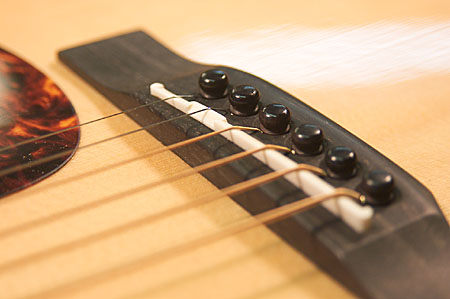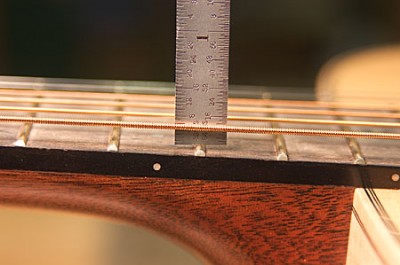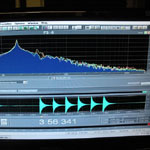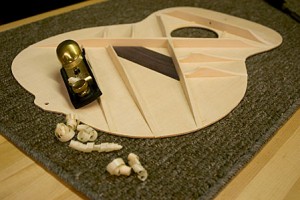 I am going to divide this article into two sections: Myths and misunderstandings about playability and care; and myths about tone. We will take these two topics in order.
I am going to divide this article into two sections: Myths and misunderstandings about playability and care; and myths about tone. We will take these two topics in order.
Playability and Care
So, your guitar is a little hard to play, the strings are a bit too high for your taste, and you are wondering how to remedy this. Or, perhaps your strings are buzzing. You log on to an Internet forum for guitar players and ask what to do about this.
Several people respond, with someone suggesting that your truss rod needs adjusted. Should adjusting the truss rod be the go-to solution for correcting buzzing or poor action?
Myth Number One: You adjust playing action with the truss rod.
Fact: The truss rod found in most guitar necks is designed to offset the pull of the strings and is for keeping the neck and fretboard flat… it is not for adjusting the height of the strings above the frets (action). Although making changes to the truss rod may affect action, the rod should be adjusted so that the neck is nearly flat with just a bit of relief. Relief is the amount of bow in the neck due to the tension of the strings. On a correctly set up guitar, the neck should be nearly flat with no string buzz. A small amount of relief may be necessary due to the oscillating pattern of the plucked strings, but this should be a slight amount- usually .006 or so for most guitars. Heavy right hand players, such as bluegrass players, may need a bit more relief due to the need for more string clearance. The harder the strings are driven, the more larger the pattern of oscillation.
The action of the guitar is set by the amount of relief, the depth of the nut slots, and the height of the saddle. Once the relief is correctly adjusted and the nut slots are correctly filed, the action is adjusted at the 12th fret by raising or lowering the saddle, not by tweaking the truss rod.
Myth Number Two: String buzzing is corrected with truss rod adjustment.
Fact: Much of the time, strings buzz because the frets are not level. Many factory brands do not dress frets on new guitars, and they ship guitars out with excess relief (bow) added to the neck to avoid string buzz and customer complaints. However, buzzing strings can be caused by several factors including nut slots that are too deep or that don’t have the correct back angle, poor break angle at the saddle, necks that are in back-bow, loose braces or other parts that are rattling, and fretboard extension rise at the body. A qualified luthier can diagnose the source of buzzing quickly and make the necessary adjustments or repairs. If the neck is flat and the action at the 12th fret is correct, there should be no string buzz. If there is, a fret dress is probably called for. For a more detailed discussion about this, see my YouTube video, Diagnosing String Buzz.
 Myth Number Three: The neck should have significant relief (up-bow) if it is set up correctly.
Myth Number Three: The neck should have significant relief (up-bow) if it is set up correctly.
Fact: This is almost universally believed by players and is perpetuated by hobby luthiers and guitar store techs. The truth is that a guitar will play at its best with a nearly flat neck. The best luthiers and expert repairmen know this and set up guitars accordingly. It bears repeating… if your neck is nearly flat within a few thousandths and the action at the 12th fret is correct, the guitar should play beautifully with no buzzing. If there is buzzing, most likely there are one or more high frets, or a high tongue extension. High frets can be addressed individually but if there are more than one or two, I recommend that all the frets be dressed (leveled, crowned, and polished.) Really aggressive players may need extra relief due to the heavy playing style but for most of us this is not the case.
Why is this so misunderstood? Many factory brands ship out guitars that do not have level fretboards or level frets. They may be close to level but with guitar geometry we often speak in terms of thousandths of an inch. Because uneven frets can buzz, factories ship guitars with the neck adjusted with excess relief. This compensates for any slight irregularities and the customers don’t complain about buzzing strings. In fairness to the factories, they also add relief because they have no control over how the guitars will be stored and handled out in the real world. Improper climate can affect geometry as well, so the factories hedge their bets and add excessive relief. Since many techs and owners assume that the factory settings are correct, they repeat them and tell others to do so as well. And the beat goes on…
Myth Number Four: As long as a guitar is stored in its case it is safe from damage.
Fact: Storing your guitar in its case is an excellent idea. I tell my customers that only one good thing can happen to a guitar when it is out of its case; everything else is bad! But it is only truly safe from damage if the humidity is maintained within the safe range for acoustic instruments. The necessity of humidifying guitars is becoming more known, but too many owners still don’t monitor and maintain the climate where they store their guitars. A safe range for humidity is 45-55%, along with a consistent room temperature of around 65-75 degrees or so. During winter in most of the US the air is much too dry for guitars, often falling into the low 30’s. Summer time air conditioning is useful to lower excessive humidity which can also be deleterious to your guitar, and a dehumidifier may be necessary in really humid environments.
Don’t blow this advice off! Maintaining adequate humidity is not difficult using a small portable humidifier or devices made for your sound hole, and monitoring the level requires an inexpensive digital hygrometer such those sold for cigar humidors. Don’t use a department store analog needle-type hygrometer, they are nearly useless for this purpose. Allowing a guitar to dehydrate can, over time, cause cracks, loose braces, bridge glue failure, and changes to the action.
We all know people who won’t take the small amount of effort to ensure the right humidity levels for their guitars and end up paying the price… don’t be one of them!
Myth Number Five: You don’t need to humidify guitars in Colorado
Fact: You can fill in the state with any other, or any other geographic location, but the fact is that there is no perfect location for a guitar so that monitoring and regulating humidity is not necessary. I know a guy from Boise, Idaho who tells people all the time that his instruments don’t require any humidity. Don’t believe it! Gravity works in Boise, and so does wood movement. Guitars want to live in the same humidity they were built in, which is why Taylor regulates its California factory at 47% relative humidity year round. Failure to maintain their guitars near that same level of humidity will result in cracked tops. Ditto for any other brand, whether factory made or hand made. I don’t know why so many players have told me that in Colorado, there is no need to humidify, but it isn’t true and I’ve got the case histories to prove it. Always measure and regulate humidity!
Now, let’s talk about one of my favorite subjects: Guitar tone myths.
Tone Myth Number One: The tone of a guitar is determined primarily by the species of tonewood it is made from.
Fact: Every component of a guitar has some impact on tone. When the subject of tone is discussed, the nearly universal belief is that the species of wood and the type of braces are the two primary factors that determine the voice of an instrument. Rarely will you hear anything about the material properties of the top wood, properties such as density, mass, modulus (resistance to deflection), or the fundamental resonances that the top and air are tuned to. Yet, these have a huge impact on the volume, clarity, balance, and sustain of a guitar. The back and side wood has less of an impact on tone than many think. This has been proven time and time again, from the famous Ramirez classical guitar made using paper mache back and sides, to the blind listening study performed by the Acoustical Society of America. To be sure, different back and side woods do impact the tone of guitars, but to much less of a degree than is commonly believed. To repeat: The material properties of the top wood used in the building of the guitar, and the correct tuning of the top, air, and back resonances, have far more to do with the tone of the completed instrument than the “tonewood” of the back and sides.
Tone Myth Number Two: Rosewood guitars have more bass, Maple guitars have less bass.
You can’t accurately compare the tone of two guitars made of different tonewoods unless both guitars are made using tops of very similar material properties and tuned to the same fundamental resonances. Only then are you comparing apples to apples. Stating that a Mahogany guitar will sound more mellow than a Maple guitar (as one example) isn’t necessarily wrong but it does indicate a possible lack of understanding about all the variables that contribute to a guitar’s tone, and the amount of tonal impact each of these have. The top, and how it is thinned, braced, and tuned, is a lot more important than the species of wood used for the back and sides. Bass response can be built into (or added to) any guitar by making the top less stiff. Stiffness damps bass.
Tone Myth Number Three: Forward-shifted bracing, scalloped bracing, or (fill in the blank) bracing is the answer to getting better tone and volume.
Fact: In a traditional X-brace pattern, the X-braces serve to provide strength for the top and also determine the fundamental resonance of the top. (All acoustic guitar tops have a fundamental resonance regardless of whether the builder knowingly manipulated it or not.) The tone bars and wing braces serve to distribute the resonance evenly throughout the bout area of the top below the sound hole. Carving the X-braces removes stiffness from the top and lowers the fundamental resonance; carving the tone and wing braces helps to get a pure, even distribution of the tone with reduced damping. The top must be thinned correctly based on its modulus, which is a measure of the top’s resistance to deflection. Volume is the result of efficiently converting of string energy to sound waves. A top that is too thick, or that is dense (heavy), or that excessive damping from being over-bracing, will not produce a loud guitar. Fancy bracing does not, by itself, produce great tone or volume.
Tone Myth Number Four: Special bridge pins improve tone.
Fact: The bridge pins keep the ball end of the strings against the bridge plate while the string is being brought to full tension. When a guitar with a healthy bridge plate and a correctly made bridge is tuned to pitch, it is possible to remove the bridge pins without effecting the strings. It is very important to string a guitar correctly to avoid damaging the bridge plate. Using the bridge pins to push the ball end into the guitar is bad practice and will result in eventual damage and a costly repair. It is my conviction that except for differences in mass (weight), the material used for the pins has no discernible impact on tone. Anything that adds or removes weight from the bridge area will affect the resonance of the top. Adding weight will lower the fundamental which can produce more warmth. This is due to a change in resonance, not a special pin material.
Tone Myth Number Five: Spruce harvested during certain phases of the moon has better tone.
Fact: I’m not kidding. Some guitar builders actually tell people this. And some of them believe it.
Tone Myth Number Six: Old guitars sound better than new guitars.
Fact: Some older guitars sound better than newer ones! An average sounding guitar is not going to evolve into Neil Young’s pre-war Martin regardless of how old it gets. This includes average sounding new Martins, of which there are plenty. Ditto for average sounding new Taylors, Gibsons, Guilds, or whatever. Most guitars do improve somewhat with age due to drying and cellular changes within the wood. A great top that has been voiced and tuned is going to age into a greater sounding top. An average top on a factory guitar is not going to age into a fabulous instrument in most cases. By the way, I’ve played Neil Young’s pre-war voiced Martin and it was an amazing sounding guitar! Martin stopped individually tuning and voicing their guitars in the late 40’s, according to Bryan Galloup of Galloup Guitars. Bryan is a nationally recognized vintage guitar repairman.
Conclusion
With the advent of the internet, there is so much information available to guitar players and builders. Some of this information is excellent, and some of it is demonstrably lacking in fact. We should all strive to learn more and have an open mind as we seek to understand this wonderful musical instrument that has brought so much joy to so many. This is true whether we are building our first guitar or our one hundredth! May we all embrace new ideas with both genuine interest and unbiased research, not rejecting these out of hand because they differ from tradition and not blindly accepting them because we want the magic answer.

